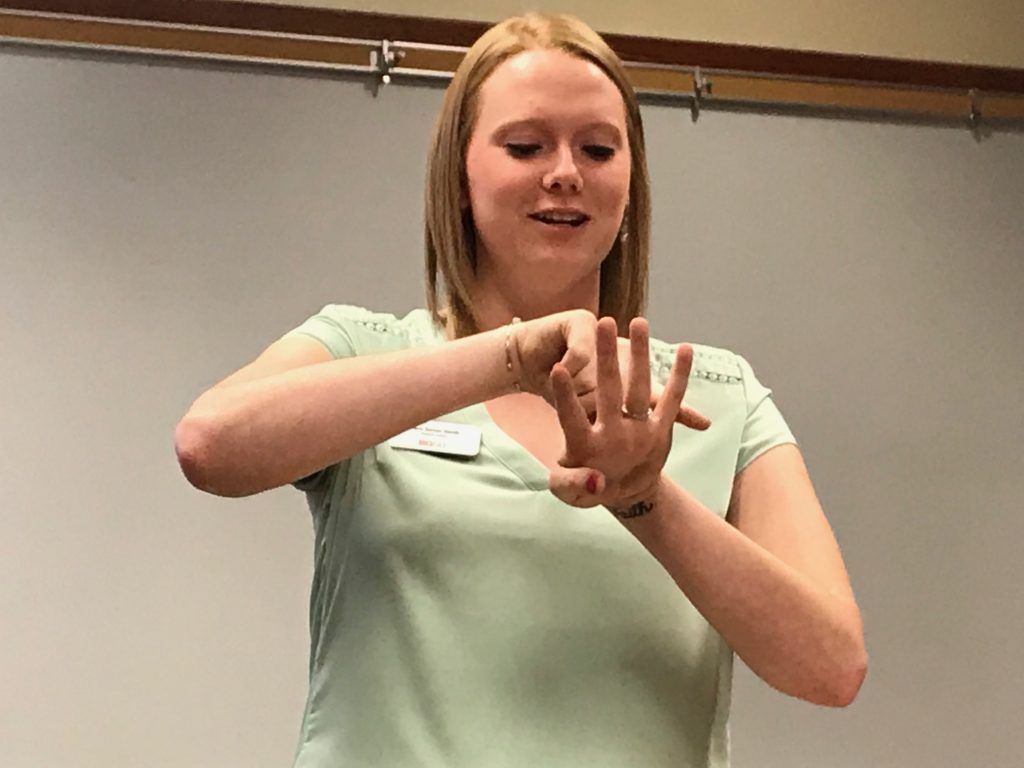By DAVID DUPONT
BG Independent News
The New Year is a time to resolve to make changes in the diet. Maybe that means starting to eat like a caveman. Or maybe it means passing on the bread.
It may even mean turning the advice to eat fruits and veggies, on its head and forgoing them.
Earlier in fall, the Wood County Library hosted a presentation by Adam Bialecki, a BGSU instructor in food and nutrition and a dietetic intern, and Sara Turner-Smith, a graduate student in food and nutrition and a dietetic intern dietetic.
Michele Raine, adult services librarian, said the library called in the dietitians because patrons have an insatiable appetite for the newest diet books.

Bialecki and Turner-Smith served up assessments of three of the most popular diets and offered some advice on better alternatives.
First up was the Ketogenic Diet. This diet was first developed to treat juvenile epilepsy. It greatly restricts consumption of carbohydrates to 20 grams or less a day, said Turner-Smith. Average consumption is about 300 grams daily. That’s about two cups of vegetables or half a bagel. The diet replaces this with fat. Normally, Turner-Smith said, the body relies on carbohydrates for energy, but the Keto diet wants to put the body in a state of ketosis, where the body starts burning its fat stores for energy.
Yes, that will produce weight loss, she said. That occurs because the dieter is cutting out a lot of food choices. Also, because of the nature of the food consumed, dehydration will occur resulting in a loss in water weight.
The diet has benefits according to studies, she said. Keto followers may see improved blood test results, including reductions in total cholesterol as well as possible benefits for those with chronic conditions such as hypertension and heart disease. And people with epilepsy may benefit from a Ketogenic diet.
But one group of people, athletes, should definitely avoid the diet. They may lose some energy production efficiency, Smith-Turner said.
Also, “any diet that’s very restrictive or takes out an entire food group throws up red flags for us,” she said. “If you have a history of eating disorders, following a very restrictive diet can be a trigger.”
With so many foods off limits, nutritional deficiencies are a real danger. And the lack of glucose, which the brain needs to function, can cause a lack of focus, Turner-Smith said.
Because many of the foods restricted — whole grains, vegetables and fruits — are also important sources of fiber, constipation often results.
There is concern about kidney damage as well.
The other problem with the Keto diet, which it shares with other “fad” diets, is sustainability, she said.
While there may be an initial period of substantial weight loss, that will taper off, Turner-Smith said.
Fad diets often promote the yo-yo effect. People lose weight through some diet, then can’t keep up with the regimen and lapse to previous eating patterns. They gain back the weight they lost and often more.
There’s no long-term data on the Keto diet. “Studies start with large sample number and by the end half or two-thirds are gone,” she said. That’s because people are unable to maintain the regimen for long enough to be studied.
The Paleo diet shares characteristics and problems with the Keto diet.
The general idea, Turner-Smith said, is to eat like a cavemen, our ancestors from the Paleolithic Era — from about 3 million years ago until about 10,000 BCE. The diet calls for contemporary humans to adapt the eating patterns of our hunter-gatherer ancestors.

Paleo eaters can consume fruits and vegetables, as well as meat, nuts, seeds, fish, shell fish, poultry, and eggs. But the approach also cuts out large swatches of the modern menu — grain, dairy, legumes, vegetable oils, refined sugar, and processed items.
“I love the focus on fruits and vegetables and whole foods, “ Turner-Smith said. “And you do cut out added salt and sugar, things we should do as well.”
This, she said, can help with blood pressure and reduce the lipids in the blood.
“But you don’t need to follow a paleo diet to do this,” she added.
Bialecki said as with any restrictive diet there will be weight loss. That comes at a price.
There are nutrient deficiencies, especially calcium and vitamin D from not including dairy, Turner-Smith said. The diet results in consuming half of the recommended amount of calcium.
“That’s pretty significant to bone health,” she said. The price of following the diet is monetary as well. Studies have found it is 10 recent more expensive to follow the Paleo diet than it is to follow a diet with the same nutrient profile.
“We don’t live in the Paleolithic Era,” she said. We know far more about nutrition. “If we have all these tools, why extract those down to nutrient deficiency.”
The gluten-free diet, Bialecki explained, was created to address a very real medical problem —celiac disease. Gluten is a protein found in most grains including wheat, barley and other grains with rice and corn being exceptions.
Those with the autoimmune disease — about 1 percent of the population — have an allergic reaction to gluten that damages their small intestine.
It is often misdiagnosed, he said, when patients report gastrointestinal distress of any sort. The only way to tell if someone has celiac disease is with a blood test.
Like the Keto diet, which was developed to treat a medical condition, gluten-free diets have been adopted by those beyond the original patient group.
Some people have come to believe that a gluten-free diet is healthier, he said.
Taking those grains out of the diet means cutting out important sources of dietary fiber, magnesium, Vitamin B12, zinc, iron, and calcium.
Often, those who follow the diet are replacing what’s taken out with simple carbohydrates, he said.
And the diet can be pricey, he said, about 200 percent more expensive.
So what’s someone who wants to eat healthy to do?
Bialecki and Turner-Smith urged balance. They explained the difference between a diet paradigm and simply eating a healthy diet.
The diet paradigm aims at a certain weight, and to achieve that has lists of forbidden foods with rules about how much, when and what to eat. They also emphasize exercise as a way to lose weight.
The best approach, the dietitians said, is a more flexible and relaxed one. “The body will seek its natural weight when individuals eat in response to cues,” one slide they displayed explained. That means how full one feels, how hungry, how food tastes. All food is acceptable.
“Everything in moderation,” Turner-Smith said.
They also urged people to be active in fun and enjoyable ways.
Not that anything goes. The healthy diet should plant based with emphasis on fiber and limits on saturated fats. The DASH (dietary approaches to stop hypertension), the Mediterranean, and Flexitarian diets meet those criteria.
Of the diet plans, Bialecki said, Weight Watchers offers a balanced approach.
Turner-Smith said the key is that it doesn’t depend of people consuming products sold by the company, rather it offers education in how to eat well.





